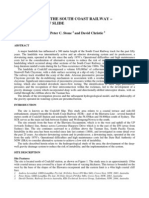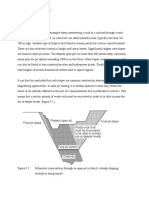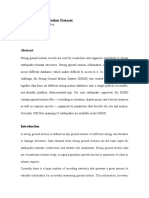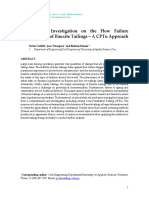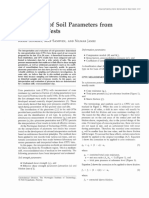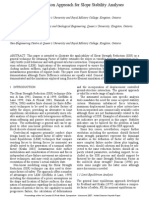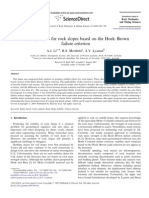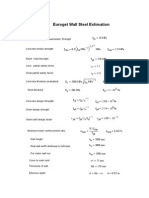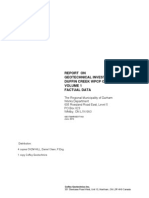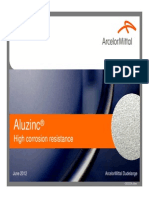Ground Motion Amplification Factors For The Proposed 2005 Edition of The National Building Code of Canada
Uploaded by
Cele Adu-wusuCopyright:
Available Formats
Ground Motion Amplification Factors For The Proposed 2005 Edition of The National Building Code of Canada
Uploaded by
Cele Adu-wusuOriginal Description:
Original Title
Copyright
Available Formats
Share this document
Did you find this document useful?
Is this content inappropriate?
Copyright:
Available Formats
Ground Motion Amplification Factors For The Proposed 2005 Edition of The National Building Code of Canada
Uploaded by
Cele Adu-wusuCopyright:
Available Formats
272
Ground motion amplification factors for the proposed 2005 edition of the National Building Code of Canada1
W.D. Liam Finn and Adrian Wightman
Abstract: Foundation factors are used in seismic codes to capture the amplification effects of local soil conditions on ground motions and, hence, on seismic design forces. Recent developments in categorizing site conditions for seismic codes and assigning intensity- and frequency-dependent amplification factors to the various site classes are presented to provide a basis for understanding the new foundation factors proposed for the 2005 edition of the National Building Code of Canada. Key words: design spectra, site characterization, amplification factors. Rsum : Des facteurs de fondation sont utiliss dans les codes sismiques afin de capturer les effets damplification que les conditions de sol locales ont sur le mouvement du sol, et par consquent, sur les forces utilises en conception sismique. De rcents dveloppements en matire de classement des conditions de site pour les codes sismiques et dattribution aux diffrentes classes de sites de facteurs damplification dpendant de lintensit et de la frquence sont prsentes. Ils procurent une base afin de comprendre les nouveaux facteurs de fondation proposs pour la prochaine dition du Code national du btiment du Canada en 2005. Mots cls : spectres de dimensionnement, caractrisation du site, facteurs damplification. [Traduit par la Rdaction] Finn and Wightman 278
Introduction
Site conditions play a major role in establishing the damage potential of incoming seismic waves from major earthquakes. Damage patterns in Mexico City after the 1985 Michoacan earthquake demonstrated conclusively the significant effects of local site conditions on seismic response of the ground. Peak accelerations of incoming motions in rock were generally less than 0.04g and had predominant periods of around 2 s. Many clay sites in the dried lakebed on which the original city was founded had site periods also around 2 s and were excited into resonant response by the incoming motions. As a result, the bedrock outcrop motions were amReceived 11 February 2002. Revision accepted 5 September 2002. Published on the NRC Research Press Web site at http://cjce.nrc.ca on 4 April 2003. Written discussion of this article is welcomed and will be received by the Editor until 31 August 2003. W.D.L. Finn. Kagawa University, Takamatsu 761-0396, Japan. A. Wightman.2,3 Klohn Crippen Consultants, Suite 500, 2955 Virtual Way, Richmond, BC V5M 4X6, Canada.
1
plified about five times. The amplified motions had devastating effects on structures with periods close to site periods. In the 1989 Loma Prieta earthquake, major damage occurred on soft soil sites in the San Francisco Oakland region where the spectral accelerations were amplified two to four times over adjacent rock sites (Housner 1989) and caused severe damage. Clearly, seismic design should incorporate the amplification effects of local soil conditions. The crucial question is how can this be done effectively without unduly complicating the structural design process or increasing the cost of engineering services significantly.
Theoretical basis of site amplification
The effects of site conditions on seismic ground motions are usually interpreted to mean how the waves from the underlying rock are affected by the geometrical and geological structures of the softer surface deposits during wave transmission to the surface. The basic mechanism of amplification is best illustrated by examining the effect of an undamped elastic surface layer on incoming bedrock motions. Consider the elastic layer shown in Fig. 1 characterized by a thickness, H, a shear wave velocity, Vss, and a density, s. Let the shear wave velocity and density in the bedrock be denoted by Vsr and r, respectively. Okamoto (1973) has shown that if the bedrock motion is a harmonic wave with a period equal to the fundamental period of the elastic surface layer (T = 4H/Vss), then the amplification factor A = at/ar for the motion at the surface of the soil layer is [1] A = 2/
2003 NRC Canada
This article is one of a selection of papers published in this Special Issue on the Proposed Earthquake Design Requirements of the National Building Code of Canada, 2005 edition. 2 Corresponding author (e-mail: awightman@bgcengineering.ca). 3 Present address: BGC Engineering Inc., Suite 500, 1045 Howe Street, Vancouver, BC V6Z 2A9, Canada.
Can. J. Civ. Eng. 30: 272278 (2003)
doi: 10.1139/L02-081
Finn and Wightman Fig. 1. Elastic layer on elastic half-space.
273 Fig. 2. Amplification of strong and weak motions at the Treasure Island site (Jarpe et al. 1989). TRI, Treasure Island surface motions; YBI, Yerba Buena Island rock motions.
where , the impedance ratio, is sVss/ rVsr; at is the surface acceleration; and ar is the incoming bedrock acceleration to the upper layer. The factor 2 in eq. [1] results from wave reflection at the surface of the soil layer. This equation represents the combined effects of the impedance ratio, input motion soil layer resonance, and the effects of the free surface. Most strong-motion instruments are located on rock or stiff soil sites and provide the database for predicting ground motions on such sites. Therefore ground motions for seismic design on softer sites are determined by first estimating what the motions would be at the site on a rock or stiff soil outcrop and then estimating how much these motions would be amplified on passing through the soft overlying soils. Therefore, the crucial question is what is the amplification ratio A between the surface acceleration at and outcrop acceleration ao shown in Fig. 1? If the soil layer has a critical damping ratio s, the amplification factor A of at with respect to the outcrop motion a0 is [2] A= 1 + s / 2
These theoretical results show that the important parameters controlling ground motion amplification in elastic surface soil layers are (i) the relationship between the predominant period of the outcrop motions and the fundamental period of the surface layer (T = 4H/Vss), (ii) the impedance between the surface layer and the base material, and (iii) the damping in the surface layer. Therefore, the key site parameters controlling the amplification of the outcrop motions are H, Vss, , and s. Under strong shaking, the response of the soil will be nonlinear. The shear modulus and damping are strain dependent, and therefore the larger strains, associated with strong shaking, reduce the effective shear moduli and increase the damping. The shear strength of the soil also puts a limitation on the magnitude of the surface acceleration because the seismic waves cannot generate shear stresses greater than the mobilized shearing resistance of the soil. Field evidence to show the effect of soil nonlinearity on ground motion amplification factors will now be reviewed. The nonlinear behaviour of soils causes the amplification factors to be dependent on the intensity of shaking. This was demonstrated very clearly by Jarpe et al. (1989) by comparing the amplification factors for a site on Treasure Island in San Francisco Bay relative to the rock motions at adjacent Yerba Buena Island, using data from the main shock of the 1989 Loma Prieta earthquake and seven subsequent aftershocks. The amplification factors for surface motions re-
corded at the Treasure Island site during the 1989 Loma Prieta earthquake are shown in Fig. 2. The solid line shows the variation in the northsouth spectral ratio for the first 5 s of the shear wave in the main shock before any liquefaction took place at the site. The shaded area in Fig. 2 shows the 95% confidence region for the spectral ratios of seven aftershocks. The amplification factors are drastically reduced in the strong-motion phase, although still 2 or greater over a wide frequency band of engineering interest. The reduction in amplification with increased intensity of shaking is due to the nonlinear stress strain response of the soil, resulting from reduced effective shear moduli and increased damping. The peak acceleration at the surface is only 0.16g, so the amplification factors are associated with fairly low levels of earthquake shaking. Idriss (1990) has summarized conveniently the relationship between peak accelerations on soft soil sites and those on associated bedrock sites in Fig. 3. The median curve is based on data recorded in Mexico City during the 1985 Michoacan earthquake and strong-motion data from the 1989 Loma Prieta earthquake. The part of the median curve for peak rock accelerations greater than 0.2g is based on one-dimensional site response analyses using the SHAKE computer program (Schnabel et al. 1972). The curve suggests that, on the average, the bedrock accelerations are amplified in soft soils until the peak rock accelerations reach about 0.4g. The higher amplification ratios between rock and soil sites, in the range of 1.54.0, are associated with levels of rock acceleration less than 0.10g, when the response is more nearly elastic. The increased nonlinearity of soft soil response at the higher accelerations reduces the amplification ratios because of the increase in hysteretic damping and the reduction in effective shear moduli. The soils in the database used by Idriss (1990) vary significantly in properties, and the sites vary in geological structure. Thus, although the curve in Fig. 3 is useful in preliminary site evaluation, it is too general for estimating amplification factors for the different classes of soft soil sites encountered in practice. In many building codes, including the present edition of the National Building Code of Canada (NBCC 1995), the amplification effects of local soil conditions are represented by foundation factors. The variety of soil conditions are compressed into four distinct site categories and an amplification factor for long-period motions, termed a foundation or site factor, is associated with each
2003 NRC Canada
274 Table 1. Foundation factors, F (NBCC 1995). Category 1 2 3 4 Type and depth of soil measured from the foundation or pile cap level
Can. J. Civ. Eng. Vol. 30, 2003
F 1.0 1.3 1.5 2.0
Rock, dense and very dense coarse-grained soils, very stiff and hard fine-grained soils; compact coarse-grained soils and firm and stiff fine-grained soils from 0 to 15 m deep Compact coarse-grained soils, firm and stiff fine-grained soils with a depth greater than 15 m; very loose and loose coarse-grained soils and very soft and soft fine-grained soils from 0 to 15 m deep Very loose and loose coarse-grained soils with depth greater than 15 m Very soft and soft fine-grained soils with depth greater than 15 m
Fig. 3. Accelerations on soft soil and associated rock sites (Idriss 1990).
[3]
Ve = vSIFW
where v is the zonal velocity ratio, S is the seismic response factor, I is the importance factor, F is the foundation factor, and W is the weight of the building. The factor F, representing site conditions, appears directly in the equation for calculating the design base shear and therefore has a direct impact on the seismic design loads. The code foundation factor, F, has a maximum value of 2 and decreases to 1 below periods of 1 s.
More comprehensive approaches to foundation factors
There are two key elements in establishing a reliable foundation factor: characterize the site condition quantitatively, and then assign a numerical value to the foundation factor for that soil category that is dependent on frequency and intensity of shaking. Two new procedures have been proposed for developing foundation factors in this way. One, by Borcherdt (1992, 1994), leads to a continuous distribution of foundation factors; the other, proposed by the National Earthquake Hazard Reduction Program (NEHRP 1994), is still based on a limited number of site categories, but the categories are defined quantitively and therefore the ambiguities of the categories in the 1995 NBCC are avoided. These two approaches will now be reviewed. They are the basis for the new foundation factors recommended for the 2005 NBCC. Continuous foundation factors Borcherdt (1992, 1994) offered an alternative approach to site characterization and the specification of the amplification factors. He used the time-averaged shear wave velocity in the top 30 m of a site, V30, as a continuous measure of site conditions and developed frequency-dependent amplification factors that are continuous functions of V30. Amplification factors were determined for 35 instrumented sites using records obtained during the 1989 Loma Prieta earthquake. The amplification is determined with respect to the Franciscan rock formation in California. The shear wave velocity in the Franciscan rock is less than 1100 m/s. Amplification factors were determined by averaging the amplification of Fourier spectra over the different period ranges shown in Fig. 4. The short-period amplification factor, designated Fa, corresponds to the average Fourier spectral ratios for recorded motions over the period range 0.10.5 s. The mid-period factor, designated Fv, is similarly defined for the period range 0.42.0 s. The variation of these factors and the corresponding factors for intermediate- and long-period ranges is
2003 NRC Canada
site category. How the system works will be illustrated using the relevant provisions of the NBCC.
Foundation factors in the 1995 NBCC
The seismic provisions of the 1995 NBCC incorporate the effects of local soil condition on design ground motions by classifying the wide variety of possible soil conditions into four categories and assigning a foundation factor, F, to each category. The foundation factors vary from 1.0 to 2.0 as shown in Table 1. Sites underlain by deposits of very soft to soft, fine-grained soils with depths greater than 15 m are assigned a foundation factor F = 2.0. The first three foundation factors are based primarily on research on site effects reported by Seed et al. (1976) and Mohraz (1976). The factor F = 2.0 was added as a result of the observation of large amplifications of incoming earthquake motions in the clay deposits of Mexico City during the 19 September 1985 earthquake in Mexico (Building Seismic Safety Council (BSSC) 1998). Justification of the value of F = 2.0 for peak rock accelerations of about 0.20g or less can be seen in the charts by both Jarpe et al. (1989) and Idriss (1990) presented earlier. It should be noted that the foundation factors are applied only to the longer period motions because of the cap on short-period motions in the 1995 NBCC. The use of broad and distinctly different soil categories has the advantage that rather distinct patterns of ground response are associated with each type. A disadvantage is that it is sometimes difficult to decide into what category complex site conditions should be assigned. In the 1995 NBCC, the equivalent lateral seismic force representing elastic response, Ve, is given by
Finn and Wightman
275
Fig. 4. Average horizontal amplification factors, F, with respect to firm to hard rock sites as a function of average shear wave velocity in the top 30 m for different period ranges (from Borcherdt (1994), used by permission of Earthquake Engineering Research Institute).
shown in Fig. 4. There is very little difference between the amplification curves for the longer periods. Figure 4 illustrates that for the softer soils there is clearly a major difference between the short-period and long-period amplification factors. Clearly there is a need to have different amplification factors for the short-period range corresponding to the approximately constant spectral acceleration segment of the response spectrum, and for the longer periods corresponding to the more or less constant velocity range. This essentially follows the approach advocated by Newmark and Hall (1982). Therefore, it was considered sufficient to use two amplification factors, Fa and Fv, to describe the amplification of outcrop motions in the short- and long-period ranges, respectively. The amplification curves in Fig. 4 are valid up to peak bedrock accelerations of 0.1g. The functional forms of these curves are [4] [5] Fa = (1050/ V30) ma Fv = (1050/ V30) mv
where ma = 0.35 and mv = 0.65 are the exponents determined by Borcherdt to give the best fit to the field data for input ground motions on rock Aa = Av = 0.10g. Fitting the curve to the data was a two-stage process. First, the shape of the curve was selected a priori as (Vref / V30) m, where Vref is the mean shear wave velocity for the selected reference ground condition and m is either ma or mv as defined above, and then values of the parameter m were selected to give the best fit to the data. There is considerable scatter, however, in the data about the empirical curves in Fig. 4 (Borcherdt 1992). 1994 NEHRP foundation factors In 1992, a 3 day meeting was held at the University of California entitled Workshop on site response during earthquakes and seismic code provisions. The workshop was attended by code committee members of the major U.S. groups involved in the development of building codes, geotechnical engineers and seismologists engaged in re-
search on site effects, and representative users of code guidelines from major consulting firms. Draft proposals for new definitions of site categories and values of the associated foundation factors were presented for discussion by Borcherdt (1992), Dobry et al. (1992), and Seed (1992). These proposals had much in common, and a consensus was reached on what modifications should be made to the existing seismic provisions for site effects in the United States (Martin and Dobry 1994). The recommendations outlined in Martin and Dobry (1994) with some minor modifications including expanded definitions of site categories were adopted in the 1994 NEHRP guidelines (NEHRP 1994). The new site categories adopted by NEHRP (1994) are shown in Table 2. Site categories were specified primarily in terms of the average shear wave velocity, V30, which is calculated from the time taken for the shear wave to travel from a depth of 30 m up to the ground surface. Thus V30 = 30/[(h/Vs)], where h and Vs represent the thickness and shear wave velocities, respectively, of the individual layers between the ground surface and 30 m depth. To facilitate the use of the site categories in practice, complementary descriptions were developed for the site categories in terms of standard penetration resistance and undrained shear strength. The appropriate ranges in these parameters for the different site categories are also given in Table 2. If shear wave velocity data are unavailable, then appropriate values can be estimated for each layer, using the average standard penetration resistance N or the average undrained shear strength Su , and then a V30 value calculated as noted earlier. Site-specific geotechnical investigations and dynamic site response analyses are recommended for soils falling into category F. Derivation of amplification factors Fa and Fv A two-factor approach was adopted for constructing the free-field acceleration response spectrum as shown in Fig. 5. The factor Fa is used for the short-period part of the response spectrum, and the factor Fv for the long-period part of the response spectrum. Values of Fa and Fv are given in Tables 3 and 4, respectively, for different levels of peak ground accelerations. The values for Fa are mean values.
2003 NRC Canada
276 Table 2. Site classification for seismic site response (NEHRP 1994). Site class A B C D E F Site class name and generic description Hard rock Rock Very dense soil and soft rock Stiff soil Soil profile with soft clay Site-specific geotechnical investigations and dynamic site response analyses: (i) soils vulnerable to potential failure or collapse under seismic loading (liquefiable soils, quick and highly sensitive clays, collapsible weakly cemented soils, etc.); (ii) peats and (or) highly organic clays (H > 3 m of peat and (or) highly organic clay, where H is thickness of soil); (iii) very high plasticity clays (H > 8 m with PI > 75); (iv) very thick soft medium-stiff clays (H > 36 m) Site class definition
Can. J. Civ. Eng. Vol. 30, 2003
V30 > 1500 m/s 760 < V30 1500 m/s 360 < V30 760 m/s, N > 50, or S u > 100 kPa 180 < V30 360 m/s, 15 N 50, or 50 S u 100 kPa V30 < 180 m/s; plasticity index PI > 20, water content w > 40%, and S u < 25 kPa
Fig. 5. Design spectra based on period-dependent site amplification factors (NEHRP 1994).
Table 3. Values of Fa as a function of site conditions and shaking intensity Aa (NEHRP 1994). Aa Site class A B C D E F 0.1g 0.8 1.0 1.2 1.6 2.5 a 0.2g 0.8 1.0 1.2 1.4 1.7 a 0.3g 0.8 1.0 1.1 1.2 1.2 a 0.4g 0.8 1.0 1.0 1.1 0.9 a 0.5g 0.8 1.0 1.0 1.0 a a
a Site-specific geotechnical investigations and dynamic site response analyses should be performed.
Table 4. Values of Fv as a function of site conditions and shaking intensity Av (NEHRP 1994). Av Site class A B C D E F
a
The values of Fv derived in the research studies were highly variable depending on site conditions and input motions. Therefore, Fv values are given at the mean plus one standard deviation level. According to Joyner and Boore (2000), the amplification factors Fa and Fv were derived as follows. For Aa and Av = 0.10g, Fa and Fv were based on Loma Prieta field data. For site class E and mapped ground accelerations greater than 0.10g, Fa and Fv were based on equivalent linear and nonlinear analyses conducted by Dobry et al. (1992) and Seed (1992). Fa and Fv for site classes C and D were derived using the general form of eqs. [4] and [5] shown in eqs. [6] and [7]: [6] [7] log Fa = ma(log Vref log V30) log Fv = mv(log Vref log V30)
0.1g 0.8 1.0 1.7 2.4 3.5 a
0.2g 0.8 1.0 1.6 2.0 3.2 a
0.3g 0.8 1.0 1.5 1.8 2.8 a
0.4g 0.8 1.0 1.4 1.6 2.4 a
0.5g 0.8 1.0 1.3 1.5 a a
Site-specific geotechnical investigations and dynamic site response analyses should be performed.
Amplification factors recommended for the 2005 NBCC
The Canadian Committee on Earthquake Engineering (CANCEE) advises on the seismic provisions of the National Building Code of Canada. CANCEE essentially adopted the NEHRP (1994) provisions for establishing the free-field acceleration response spectrum and the NEHRP site classes for the 2005 NBCC. The short- and long-period amplification factors Fa and Fv, respectively, were adopted also with some minor modifications. The 2005 NBCC factors are in Tables 6 and 7. The intensity of shaking in these
2003 NRC Canada
The values of Fa and Fv for site class E were used in eqs. [6] and [7] to determine values of ma and mv for mapped accelerations Aa and Av greater than 0.10g. These values were then inserted in eqs. [6] and [7] to obtain Fa and Fv for site classes C and D for the corresponding accelerations. The ma and mv values for the acceleration categories shown in Tables 3 and 4 are given in Table 5.
Finn and Wightman Table 5. Values of exponents ma and mv at different shaking intensities. Rock acceleration (g) 0.1 0.2 0.3 0.4 ma 0.35 0.25 0.10 0.05 mv 0.65 0.60 0.53 0.45 Site class A B C D E F Table 7. Values of Fv as a function of site class and spectral acceleration at T = 1.0 s (S1.0). S1.0 0.25 0.5 0.6 1.0 1.4 2.1 a 0.50 0.5 0.7 1.0 1.3 2.0 a 0.75 0.5 0.7 1.0 1.2 1.9 a 1.00 0.6 0.8 1.0 1.1 1.7 a 1.25 0.6 0.8 1.0 1.1 1.7 a
277
Table 6. Values of Fa as a function of site class and spectral acceleration at T = 0.2 s (S0.2). S0.2 Site class A B C D E F 0.25 0.7 0.8 1.0 1.3 2.1 a 0.50 0.7 0.8 1.0 1.2 1.4 a 0.75 0.8 0.9 1.0 1.1 1.1 a 1.00 0.8 1.0 1.0 1.1 0.9 a 1.25 0.8 1.0 1.0 1.0 0.9 a
Note: Use straight-line interpolation for intermediate values of S1.0. a Site-specific geotechnical investigation and dynamic site response analyses should be performed.
Note: Use straight-line interpolation for intermediate values of S0.2. a Site-specific geotechnical investigation and dynamic site response analyses should be performed.
tables is defined by the short-period (T = 0.2 s) and longperiod (T = 1.0 s) spectral accelerations S0.2 and S1.0, respectively. The probabilistic spectral accelerations at these two periods define the uniform hazard spectrum adopted in the 2005 NBCC. The seismic hazard mapping by the Geological Survey of Canada to determine these values is described by Adams and Halchuk (2003). Numerical values for major population centres across Canada will be provided in the 2005 NBCC. CANCEE adopted site class C in NEHRP (1994) as the reference site for amplification for the 2005 NBCC, instead of site class B as used in the NEHRP (1994) provisions. Site class C is very similar to the reference site in the current code. Therefore, for all intensities of earthquake shaking, the site factor for site C is 1.0. This neglects the deamplifications for this site class under strong shaking given in the NEHRP (Tables 3 and 4). The CANCEE amplification factors shown in Tables 6 and 7 for site classes D and E were determined by maintaining the relative amplifications between these classes and site class C as found in the NEHRP Tables 3 and 4.
Concluding remarks
The effect of local soil conditions on ground motions may be incorporated into building codes using site amplification factors. The factors are associated with a limited number of site classes that are intended to encompass the wide variety of site conditions encountered in practice. These factors measure the amplification of design motion parameters for a given site class with respect to the mapped code design values for the site class selected as the reference or standard site. The standard site in the 2005 NBCC is the equivalent of soft rock or stiff soil. The site categories in the 2005 NBCC are defined primarily by ranges in the average shear wave velocity, V30, in the top 30 m at the site. Since V30 may often not be available, the site categories are also defined using
the average standard penetration resistance, N 60, for cohesionless soils and the average undrained shear strength, Su , for cohesive soils. The two latter parameters are often available from routine site investigations. The site classes adopted in the 2005 NBCC are those recommended in NEHRP (1994). The foundation factors in the 2005 NBCC were obtained by adjusting the factors recommended by NEHRP (1994) and adopted in BSSC (1998) and the 1997 Uniform Building Code (ICBO 1997) to the Canadian reference site. In addition, other site classes are identified for which site-specific dynamic response studies are recommended for determining the amplification factors. The amplification factors recommended by NEHRP (Tables 3 and 4) have some limitations. Only the factors for mapped ground motions less than 0.10g are based on field data. They rely exclusively on data from just one case, the Loma Prieta earthquake. Factors for the softest site class, class E, were determined by hundreds of dynamic response analyses for mapped ground motions ranging from 0.10g to 0.5g. Factors for site classes C and D for mapped ground motions ranging from 0.10g to 0.5g were obtained by interpolation. Therefore, there is considerable uncertainty associated with the foundation factors. Despite the limitations cited earlier, the provisions for determining amplification factors recommended in the 2005 NBCC are an improvement over the provisions in the current code. The major benefit is the way in which the new site classes are defined. By using values of soil parameters such as shear wave velocity, penetration resistance, and shear strength to define site classes, many of the troublesome ambiguities associated with the descriptive definitions in the current code have been removed. The new foundation factors are intensity dependent and reflect the effects of nonlinearity during strong shaking by a reduction in amplification. Lastly, by selecting site class C as the reference site for the 2005 NBCC, the maximum values of the new amplification factors are not significantly different from the values in the present code. Therefore, there is no significant penalty attached to the use of the new factors.
Addendum
A crucial report by Borcherdt (2002) became available as this paper was being processed for publication. His conclusions are so critical for assessment of the amplification fac 2003 NRC Canada
278
Can. J. Civ. Eng. Vol. 30, 2003 Dobry, R., Martin, G.R., Parra, E., and Bhattacharyya, A. 1992. Development of site-dependent ratios of elastic response spectra (RRS) and site categories for building seismic codes. In Proceedings of the NCEER, SEAOC, BSSC Workshop on Site Response During Earthquakes and Seismic Code Provisions, 1820 Nov. 1992, University of Southern California, Los Angeles, Calif. Edited by G.R. Martin. Housner, G.W. 1989. Competing against time. Report to Governor Deukmejian of California, Governors Board of Inquiry on the 1989 Loma Prieta Earthquake. Idriss, I.M. 1990. Response of soft soil sites during earthquakes. In Proceedings of the H. Bolton Seed Memorial Symposium, Berkeley, Calif. Edited by J.M. Duncan. BiTech Publishers, Vancouver, B.C. Vol. 2, pp. 273289. ICBO. 1997. Uniform Building Code, International Council of Building Officials, Whittier, Calif. Jarpe, S., Hutchings, L., Hauk, T., and Shakal, A. 1989. Selected strong- and weak-motion data from the Loma Prieta earthquake sequence. Seismological Research Letters, 60: 167176. Joyner, W.B., and Boore, D.M. 2000. Recent developments in earthquake ground motion estimation. In Proceedings of the 6th International Conference on Seismic Zonation, 1215 Nov. 2000, Earthquake Engineering Research Institute, Oakland, Calif. Vol. II, pp. 679685. Martin, G.R., and Dobry, R. 1994. Earthquake site response and seismic code provisions. NCEER Bulletin, Vol. 8, No. 4, October. Mohraz, B. 1976. Earthquake spectra for different geologic conditions. Bulletin of the Seismological Society of America, 66: 915935. NBCC. 1995. National Building Code of Canada 1995. Institute for Research in Construction, National Research Council of Canada, Ottawa, Ont. NEHRP. 1994. 1994 Recommended provisions for seismic regulations of new buildings: Part 1, provisions. FEMA 222A, National Earthquake Hazard Reduction Program, Federal Emergency Management Agency, Washington, D.C. Newmark, N.M., and Hall, W.J. 1982. Earthquake spectra and design monograph series. Earthquake Engineering Research Institute, Oakland, Calif. Okamoto, S. 1973. Introduction to earthquake engineering. University of Tokyo Press, Tokyo, Japan. Schnabel, P.B., Lysmer, J., and Seed, H.B. 1972. SHAKE: a computer program for earthquake response analysis of horizontally layered sites. Report EERC 71-12, University of California at Berkeley, Berkeley, Calif. Seed, R.B. 1992. Site effects on strong shaking: recent developments for seismic design codes and practice. In Proceedings of the NCEER, SEAOC, BSSC Workshop on Site Response During Earthquakes and Seismic Code Provisions, 1820 Nov. 1992, University of Southern California, Los Angeles, Calif. Edited by G.R. Martin. Seed, H.B., Ugas, C., and Lysmer, J. 1976. Site-dependent spectra for earthquake-resistant design. Bulletin of the Seismological Society of America, 66(1): 221243.
tors recommended for the 2005 NBCC that the publisher agreed to add the following comments. Since the form of the site classes and the specifications for foundation factors were set in 1992, much new field data have become available that are still being processed. The Northridge earthquake in 1994 has provided much data on the seismic response of the stiffer site classes and at very high levels of shaking. The Kobe earthquake of 1995 has provided similar data for the stiffer site classes but more importantly for the soft class E sites. The data from these earthquakes are being studied to verify the validity of the foundation factors proposed by NEHRP and, therefore, by implication the factors proposed in the 2005 NBCC. Borcherdt (2002), who was one of the leading figures in the development of the original NEHRP factors, reports that data from the 17 January 1994 Northridge earthquake support the NEHRP amplification factors adopted in U.S. codes for site classes C and D for base accelerations up to 0.5g and that no changes in the present code provisions are justified.
Acknowledgements
The first author is grateful for the invitation to participate in the 1992 workshop at which the NEHRP recommendations were developed. The authors gratefully acknowledge the help and documentation provided by the late Bill Joyner, U.S. Geological Survey. His contributions to our profession will be sorely missed.
References
Adams, J., and Halchuk, S. 2003. Fourth generation seismic hazard maps of Canada: Values for over 650 Canadian localities intended for the 2005 National Building Code of Canada. Geological Survey of Canada Open File 4459. 155 p. Available from http://www.seismo/nrcan.gc.ca as of 1 April 2003. Borcherdt, R.D. 1992. Simplified site classes and empirical amplification factors for site-dependent code provisions. In Proceedings of the NCEER, SEAOC, BSSC Workshop on Site Response During Earthquakes and Seismic Code Provisions, 1820 Nov. 1992, University of Southern California, Los Angeles, Calif. Edited by G.R. Martin. Borcherdt, R.D. 1994. Estimates of site-dependent response spectra for design (methodology and justification). Earthquake Spectra, 10(4): 617653. Borcherdt, R.D. 2002. Empirical evidence for site coefficients in building code provisions. Earthquake Spectra, 18(2): 189217. BSSC. 1998. 1997 Edition NEHRP recommended provisions for seismic regulations for new buildings and other structures. Part 1 (provisions) and part 2 (commentary). FEMA 302/303, Building Seismic Safety Council, Federal Emergency Management Agency, Washington, D.C.
2003 NRC Canada
You might also like
- An Improved Method of Matching Response Spectra of Recorded Earthquake Ground Motion Using Wavelets PDFNo ratings yetAn Improved Method of Matching Response Spectra of Recorded Earthquake Ground Motion Using Wavelets PDF23 pages
- Evaluation of Seismic Performance in Mechanically StabilizedNo ratings yetEvaluation of Seismic Performance in Mechanically Stabilized4 pages
- Diatomaceous Soils A Less-Than-Cromulent Engineering MaterialNo ratings yetDiatomaceous Soils A Less-Than-Cromulent Engineering Material8 pages
- Mechanical Techniques - Particle Size Separation PDFNo ratings yetMechanical Techniques - Particle Size Separation PDF13 pages
- Debris Flows in Areas of Residual Soils: Occurrence and CharacteristicsNo ratings yetDebris Flows in Areas of Residual Soils: Occurrence and Characteristics9 pages
- The Use of Pore-Pressure Coefficients in Practice100% (1)The Use of Pore-Pressure Coefficients in Practice5 pages
- Carrier Commercial Systems 2008 List Prices: 30Rb Air Cooled ChillersNo ratings yetCarrier Commercial Systems 2008 List Prices: 30Rb Air Cooled Chillers13 pages
- Pre-Earthquake Processes: A Multidisciplinary Approach to Earthquake Prediction StudiesFrom EverandPre-Earthquake Processes: A Multidisciplinary Approach to Earthquake Prediction StudiesNo ratings yet
- Assessment of Slope Stability: Serge - Leroueil@gci - Ulaval.caNo ratings yetAssessment of Slope Stability: Serge - Leroueil@gci - Ulaval.ca35 pages
- Discrete Element Approach For Mine Dump Stability Analysis PDFNo ratings yetDiscrete Element Approach For Mine Dump Stability Analysis PDF5 pages
- A Rainfall Infiltration Model For Unsaturated Soil SlopeNo ratings yetA Rainfall Infiltration Model For Unsaturated Soil Slope8 pages
- Liquefied Srength Ratio From Liquefaction Flow Failure Casa HistoriesNo ratings yetLiquefied Srength Ratio From Liquefaction Flow Failure Casa Histories19 pages
- Factors Affecting Vibration Induced SettlementNo ratings yetFactors Affecting Vibration Induced Settlement6 pages
- G - Articulo - Jibson - Predicting Earthquake-Induced Landslide Displacements Using Newmark's Sliding Block Analysis100% (1)G - Articulo - Jibson - Predicting Earthquake-Induced Landslide Displacements Using Newmark's Sliding Block Analysis23 pages
- (2001) Estimating The Geotechnical Properties of Heterogeneous Rock Masses Such As FlyschNo ratings yet(2001) Estimating The Geotechnical Properties of Heterogeneous Rock Masses Such As Flysch15 pages
- Determination of The Characteristic Frequency of Two Dams Located in The Region of Calabria, ItalyNo ratings yetDetermination of The Characteristic Frequency of Two Dams Located in The Region of Calabria, Italy9 pages
- Seismic-Wave-Based Testing in Geotechnical Engineering. Stokoe & SantamarinaNo ratings yetSeismic-Wave-Based Testing in Geotechnical Engineering. Stokoe & Santamarina47 pages
- Geotechnical Investigation On The Flow Failure Susceptibility of Bauxite Tailings - CPTu ApproachNo ratings yetGeotechnical Investigation On The Flow Failure Susceptibility of Bauxite Tailings - CPTu Approach12 pages
- Geochemical and Mineralogic Characterization of SolidsNo ratings yetGeochemical and Mineralogic Characterization of Solids47 pages
- Copywright 9 1969 by ASTM InternationalNo ratings yetCopywright 9 1969 by ASTM International25 pages
- Mechanical Properties of Frozen Soils: 5.1 Stress-Strain-Time and Strength BehaviorNo ratings yetMechanical Properties of Frozen Soils: 5.1 Stress-Strain-Time and Strength Behavior31 pages
- 06 Simplified Procedure For Estimating Seismic Slope Displacements For Subduction Zone Earthquakes (Bray Et Al. 2018)No ratings yet06 Simplified Procedure For Estimating Seismic Slope Displacements For Subduction Zone Earthquakes (Bray Et Al. 2018)13 pages
- Plastic Hardening Model - Theory and Examples PDFNo ratings yetPlastic Hardening Model - Theory and Examples PDF36 pages
- Critical State Soil Mechanics: Andrew Schofield and Peter WrothNo ratings yetCritical State Soil Mechanics: Andrew Schofield and Peter Wroth3 pages
- Gazetas (1982) - Shear Vibrations of Vertically Inhomogeneous Earth DamsNo ratings yetGazetas (1982) - Shear Vibrations of Vertically Inhomogeneous Earth Dams23 pages
- 1987-Seismic Response of Earth Dams Some RecentNo ratings yet1987-Seismic Response of Earth Dams Some Recent46 pages
- 1 Slope Stability For A Cohesive and Frictional Soil: 1.1 Problem StatementNo ratings yet1 Slope Stability For A Cohesive and Frictional Soil: 1.1 Problem Statement10 pages
- Sunneset & Al (1989) - Evaluation of Soil Parameters FromNo ratings yetSunneset & Al (1989) - Evaluation of Soil Parameters From14 pages
- Seismically Induced Failure of Rock Slopes: Insights From Field Observations and Analytical ModelingNo ratings yetSeismically Induced Failure of Rock Slopes: Insights From Field Observations and Analytical Modeling15 pages
- Probabilistic Landslide Hazard Methodology For A Highly Susceptible Area To LandslidesNo ratings yetProbabilistic Landslide Hazard Methodology For A Highly Susceptible Area To Landslides9 pages
- Three-Dimensional Finite Element Analysis of Soil Geogrid Interaction Under Pullout Loading ConditionNo ratings yetThree-Dimensional Finite Element Analysis of Soil Geogrid Interaction Under Pullout Loading Condition8 pages
- Estimation of Hydraulic Conductivity From Grain Size AnalysesNo ratings yetEstimation of Hydraulic Conductivity From Grain Size Analyses96 pages
- Assessment of Mass Modulus of A WeatheredNo ratings yetAssessment of Mass Modulus of A Weathered4 pages
- Stability Charts For Rock Slopes Based On The Hoek-Brown Failure CriterionNo ratings yetStability Charts For Rock Slopes Based On The Hoek-Brown Failure Criterion12 pages
- Normal Fault Rupture Interaction With Strip FoundationsNo ratings yetNormal Fault Rupture Interaction With Strip Foundations12 pages
- Probabilistic Seismic Hazard Analysis (FERC Chapter-R20, Draft 2014)No ratings yetProbabilistic Seismic Hazard Analysis (FERC Chapter-R20, Draft 2014)84 pages
- Temporary Stability of Steep Noncemented and Lightly Cemented Soil SlopesNo ratings yetTemporary Stability of Steep Noncemented and Lightly Cemented Soil Slopes11 pages
- Studies of Rainfall-Induced Slope Failures: H. Rahardjo, E.C. Leong & R.B. RezaurNo ratings yetStudies of Rainfall-Induced Slope Failures: H. Rahardjo, E.C. Leong & R.B. Rezaur15 pages
- Mkaj 1093 - Unsaturated Soil Mechanics Project SEMESTER II, SESSION 2020/20210% (1)Mkaj 1093 - Unsaturated Soil Mechanics Project SEMESTER II, SESSION 2020/20213 pages
- An Introduction to Thermogeology: Ground Source Heating and CoolingFrom EverandAn Introduction to Thermogeology: Ground Source Heating and CoolingNo ratings yet
- Westney Heights Baptist Church: DisciplineNo ratings yetWestney Heights Baptist Church: Discipline4 pages
- 3179 - Programme at A Glance - Single Pages Proof1No ratings yet3179 - Programme at A Glance - Single Pages Proof15 pages
- Ghana: National Progress Report On The Implementation of The Hyogo Framework For ActionNo ratings yetGhana: National Progress Report On The Implementation of The Hyogo Framework For Action17 pages
- Construction Material and Testing: Psalms 127:1No ratings yetConstruction Material and Testing: Psalms 127:147 pages
- Direct Manpower: PM1 PM2 PM3 PM4 PM5 PM6 PM7No ratings yetDirect Manpower: PM1 PM2 PM3 PM4 PM5 PM6 PM755 pages
- Triveni Kala Sangam India International Center Case StudyNo ratings yetTriveni Kala Sangam India International Center Case Study1 page
- Ceiling Joist With Attic Storage (PDF) 201703231433226145No ratings yetCeiling Joist With Attic Storage (PDF) 2017032314332261455 pages
- Utilization of Sawdust in Making Concrete Blocks: An Experimental Research On Hollow Concrete Block's RigidityNo ratings yetUtilization of Sawdust in Making Concrete Blocks: An Experimental Research On Hollow Concrete Block's Rigidity10 pages
- Análisis Comparativo Entre Pavimento Rígido y FlexibleNo ratings yetAnálisis Comparativo Entre Pavimento Rígido y Flexible1 page
- Quality Control of Miscellaneous Construction Materials - Jayson - Margallo 1No ratings yetQuality Control of Miscellaneous Construction Materials - Jayson - Margallo 174 pages
- Compatibility Between Polycarboxylate-Based Admixtures and Blended Cement PasteNo ratings yetCompatibility Between Polycarboxylate-Based Admixtures and Blended Cement Paste12 pages
- Understanding Pressure Relieving Devices PDF100% (1)Understanding Pressure Relieving Devices PDF300 pages
- An Improved Method of Matching Response Spectra of Recorded Earthquake Ground Motion Using Wavelets PDFAn Improved Method of Matching Response Spectra of Recorded Earthquake Ground Motion Using Wavelets PDF
- Evaluation of Seismic Performance in Mechanically StabilizedEvaluation of Seismic Performance in Mechanically Stabilized
- Diatomaceous Soils A Less-Than-Cromulent Engineering MaterialDiatomaceous Soils A Less-Than-Cromulent Engineering Material
- Mechanical Techniques - Particle Size Separation PDFMechanical Techniques - Particle Size Separation PDF
- Debris Flows in Areas of Residual Soils: Occurrence and CharacteristicsDebris Flows in Areas of Residual Soils: Occurrence and Characteristics
- Carrier Commercial Systems 2008 List Prices: 30Rb Air Cooled ChillersCarrier Commercial Systems 2008 List Prices: 30Rb Air Cooled Chillers
- Pre-Earthquake Processes: A Multidisciplinary Approach to Earthquake Prediction StudiesFrom EverandPre-Earthquake Processes: A Multidisciplinary Approach to Earthquake Prediction Studies
- Assessment of Slope Stability: Serge - Leroueil@gci - Ulaval.caAssessment of Slope Stability: Serge - Leroueil@gci - Ulaval.ca
- Discrete Element Approach For Mine Dump Stability Analysis PDFDiscrete Element Approach For Mine Dump Stability Analysis PDF
- A Rainfall Infiltration Model For Unsaturated Soil SlopeA Rainfall Infiltration Model For Unsaturated Soil Slope
- Liquefied Srength Ratio From Liquefaction Flow Failure Casa HistoriesLiquefied Srength Ratio From Liquefaction Flow Failure Casa Histories
- G - Articulo - Jibson - Predicting Earthquake-Induced Landslide Displacements Using Newmark's Sliding Block AnalysisG - Articulo - Jibson - Predicting Earthquake-Induced Landslide Displacements Using Newmark's Sliding Block Analysis
- (2001) Estimating The Geotechnical Properties of Heterogeneous Rock Masses Such As Flysch(2001) Estimating The Geotechnical Properties of Heterogeneous Rock Masses Such As Flysch
- Determination of The Characteristic Frequency of Two Dams Located in The Region of Calabria, ItalyDetermination of The Characteristic Frequency of Two Dams Located in The Region of Calabria, Italy
- Seismic-Wave-Based Testing in Geotechnical Engineering. Stokoe & SantamarinaSeismic-Wave-Based Testing in Geotechnical Engineering. Stokoe & Santamarina
- Geotechnical Investigation On The Flow Failure Susceptibility of Bauxite Tailings - CPTu ApproachGeotechnical Investigation On The Flow Failure Susceptibility of Bauxite Tailings - CPTu Approach
- Geochemical and Mineralogic Characterization of SolidsGeochemical and Mineralogic Characterization of Solids
- Mechanical Properties of Frozen Soils: 5.1 Stress-Strain-Time and Strength BehaviorMechanical Properties of Frozen Soils: 5.1 Stress-Strain-Time and Strength Behavior
- 06 Simplified Procedure For Estimating Seismic Slope Displacements For Subduction Zone Earthquakes (Bray Et Al. 2018)06 Simplified Procedure For Estimating Seismic Slope Displacements For Subduction Zone Earthquakes (Bray Et Al. 2018)
- Critical State Soil Mechanics: Andrew Schofield and Peter WrothCritical State Soil Mechanics: Andrew Schofield and Peter Wroth
- Gazetas (1982) - Shear Vibrations of Vertically Inhomogeneous Earth DamsGazetas (1982) - Shear Vibrations of Vertically Inhomogeneous Earth Dams
- 1 Slope Stability For A Cohesive and Frictional Soil: 1.1 Problem Statement1 Slope Stability For A Cohesive and Frictional Soil: 1.1 Problem Statement
- Sunneset & Al (1989) - Evaluation of Soil Parameters FromSunneset & Al (1989) - Evaluation of Soil Parameters From
- Seismically Induced Failure of Rock Slopes: Insights From Field Observations and Analytical ModelingSeismically Induced Failure of Rock Slopes: Insights From Field Observations and Analytical Modeling
- Probabilistic Landslide Hazard Methodology For A Highly Susceptible Area To LandslidesProbabilistic Landslide Hazard Methodology For A Highly Susceptible Area To Landslides
- Three-Dimensional Finite Element Analysis of Soil Geogrid Interaction Under Pullout Loading ConditionThree-Dimensional Finite Element Analysis of Soil Geogrid Interaction Under Pullout Loading Condition
- Estimation of Hydraulic Conductivity From Grain Size AnalysesEstimation of Hydraulic Conductivity From Grain Size Analyses
- Stability Charts For Rock Slopes Based On The Hoek-Brown Failure CriterionStability Charts For Rock Slopes Based On The Hoek-Brown Failure Criterion
- Normal Fault Rupture Interaction With Strip FoundationsNormal Fault Rupture Interaction With Strip Foundations
- Probabilistic Seismic Hazard Analysis (FERC Chapter-R20, Draft 2014)Probabilistic Seismic Hazard Analysis (FERC Chapter-R20, Draft 2014)
- Temporary Stability of Steep Noncemented and Lightly Cemented Soil SlopesTemporary Stability of Steep Noncemented and Lightly Cemented Soil Slopes
- Studies of Rainfall-Induced Slope Failures: H. Rahardjo, E.C. Leong & R.B. RezaurStudies of Rainfall-Induced Slope Failures: H. Rahardjo, E.C. Leong & R.B. Rezaur
- Mkaj 1093 - Unsaturated Soil Mechanics Project SEMESTER II, SESSION 2020/2021Mkaj 1093 - Unsaturated Soil Mechanics Project SEMESTER II, SESSION 2020/2021
- An Introduction to Thermogeology: Ground Source Heating and CoolingFrom EverandAn Introduction to Thermogeology: Ground Source Heating and Cooling
- 3179 - Programme at A Glance - Single Pages Proof13179 - Programme at A Glance - Single Pages Proof1
- Ghana: National Progress Report On The Implementation of The Hyogo Framework For ActionGhana: National Progress Report On The Implementation of The Hyogo Framework For Action
- Triveni Kala Sangam India International Center Case StudyTriveni Kala Sangam India International Center Case Study
- Ceiling Joist With Attic Storage (PDF) 201703231433226145Ceiling Joist With Attic Storage (PDF) 201703231433226145
- Utilization of Sawdust in Making Concrete Blocks: An Experimental Research On Hollow Concrete Block's RigidityUtilization of Sawdust in Making Concrete Blocks: An Experimental Research On Hollow Concrete Block's Rigidity
- Análisis Comparativo Entre Pavimento Rígido y FlexibleAnálisis Comparativo Entre Pavimento Rígido y Flexible
- Quality Control of Miscellaneous Construction Materials - Jayson - Margallo 1Quality Control of Miscellaneous Construction Materials - Jayson - Margallo 1
- Compatibility Between Polycarboxylate-Based Admixtures and Blended Cement PasteCompatibility Between Polycarboxylate-Based Admixtures and Blended Cement Paste
